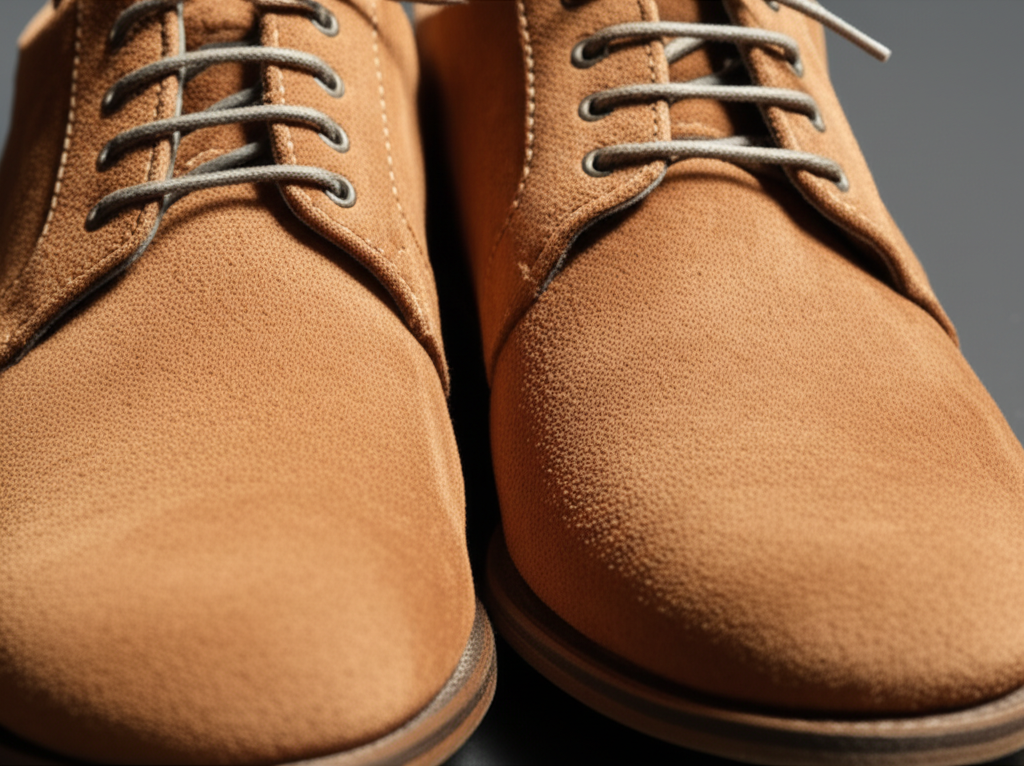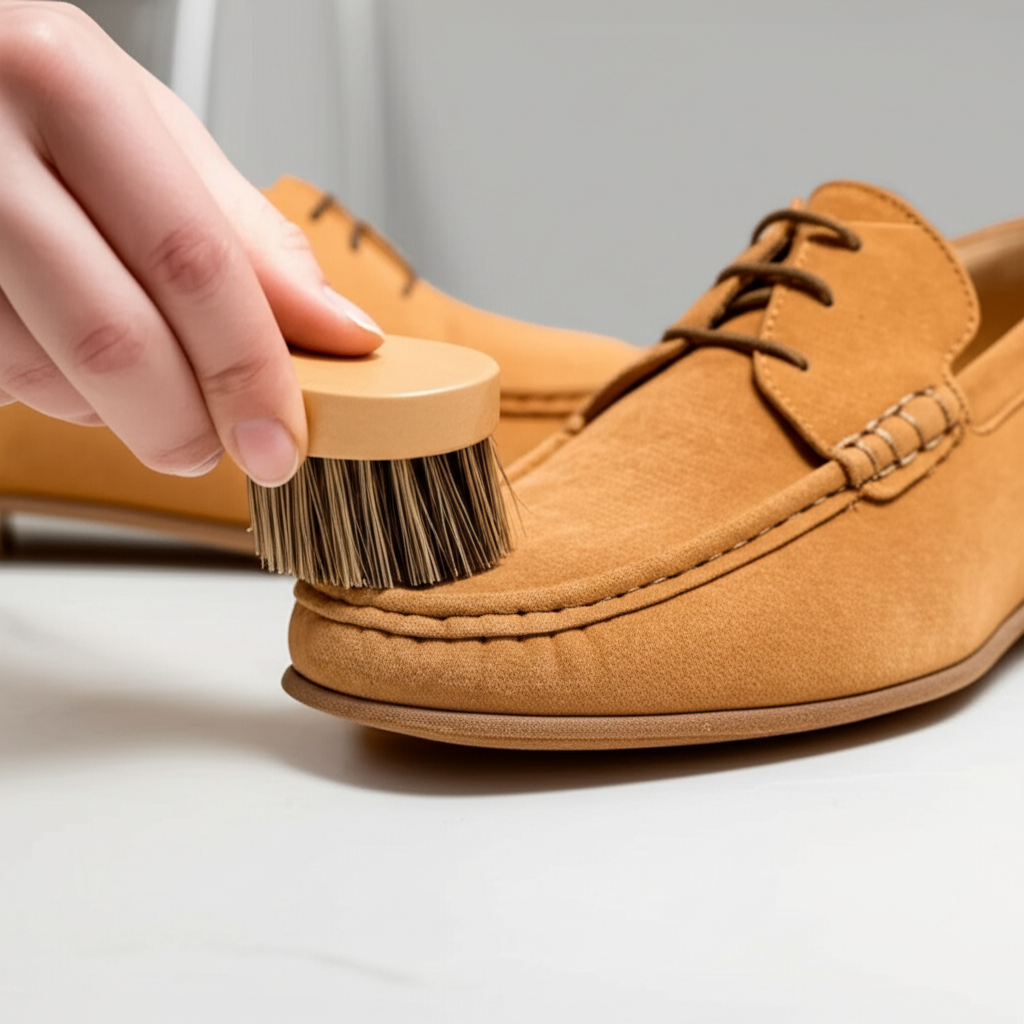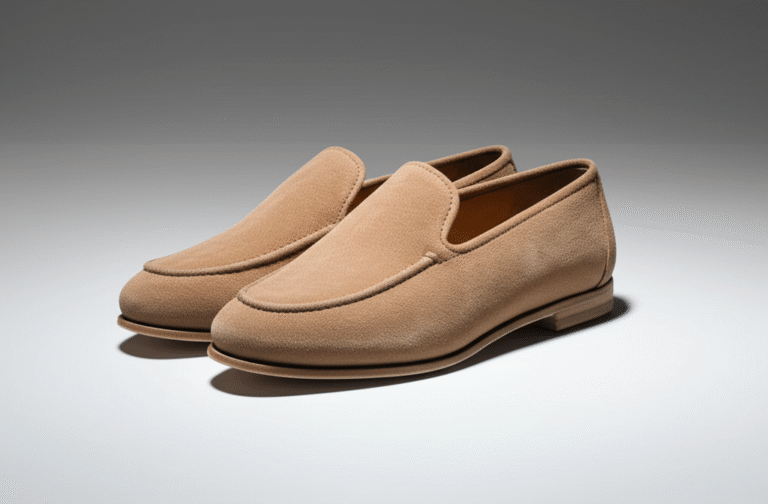To get an effortless shine on your suede shoes, gently brush away dry dirt with a suede brush, then use a specialized suede eraser for stains. For tougher marks, a damp cloth or a bit of white vinegar can work wonders, followed by a final brush to restore the nap.
Key Takeaways
- Brush off loose dirt first.
- Use a suede eraser for marks.
- Tackle stains with vinegar or water.
- Restore nap with a suede brush.
- Protect your suede shoes regularly.
- Act quickly on fresh spills.
How to Clean Suede Shoes: Effortless Shine for Your Favorite Footwear
Suede shoes are stylish. They can also be tricky to keep clean. Many people worry about damaging them. But cleaning suede doesn’t have to be hard. You can easily restore your suede shoes to look like new. This guide will show you how. We’ll cover everything from basic cleaning to tackling tough stains. Get ready to give your suede shoes an effortless shine.
Why Suede Needs Special Care

Suede is a type of leather. It has a soft, fuzzy texture. This texture comes from the underside of the animal skin. It’s what makes suede so appealing. However, this soft nap makes it very absorbent. It can easily pick up dirt, dust, and liquids. Unlike smooth leather, you can’t just wipe suede clean with a damp cloth. Water can actually stain suede. It can flatten the nap. It can also leave water marks. This is why specialized tools and techniques are important for cleaning suede.
Understanding your suede shoes is the first step. Different types of suede might react slightly differently. For instance, nubuck is a type of suede with a finer grain. It’s a bit more durable. But generally, the cleaning principles are the same. You need to be gentle. You need to use the right tools. This guide will give you the confidence to clean your suede shoes yourself. You’ll save money and keep your favorite footwear looking great.
Essential Tools for Cleaning Suede Shoes
Before you start cleaning, gather your supplies. Having the right tools makes the job much easier. You don’t need a lot of fancy products. Most of these are affordable and readily available. Here’s what you’ll need:
- Suede Brush: This is your most important tool. A good suede brush has soft nylon or brass bristles. It helps remove dirt and restore the nap.
- Suede Eraser (or Pencil Eraser): These are like magic erasers for suede. They can lift dry stains and marks without damaging the material. A clean pencil eraser can work in a pinch.
- Clean Cloths: You’ll need a few clean, dry microfiber cloths. These are soft and won’t leave lint behind.
- White Vinegar: A surprising but effective stain remover for tougher spots.
- Cornstarch or Talcum Powder: Great for absorbing fresh liquid spills.
- Waterproof Suede Protector Spray: This is for after cleaning. It helps prevent future stains.
- Optional: Shoe Trees: Cedar shoe trees help maintain shoe shape and absorb moisture.
Step-by-Step Guide: How to Clean Suede Shoes

Cleaning suede shoes can be broken down into simple steps. Always start with the least aggressive method. Work your way up if needed. Patience is key when cleaning suede.
Step 1: Dry Brushing to Remove Loose Dirt
This is the first and most crucial step. It removes surface dirt before it can become embedded. Make sure your shoes are completely dry before you start. If they are wet, let them air dry naturally. Never use heat like a hairdryer, as this can damage the suede.
Take your suede brush. Brush the entire shoe gently. Always brush in the same direction. This helps to lift dirt and debris. It also starts to restore the nap, which is the fuzzy texture of the suede.
For stubborn dry dirt, you can brush back and forth a little more firmly. But still, be careful not to be too aggressive. You don’t want to damage the delicate fibers.
Step 2: Tackling Stains with a Suede Eraser
Once you’ve removed loose dirt, it’s time to address any marks or stains. For most scuffs and dry marks, a suede eraser is your best friend. It works similarly to a pencil eraser but is designed specifically for suede.
Gently rub the eraser over the stained area. Apply light pressure. You should see the mark start to lift. After erasing, use your suede brush to brush away any eraser residue. Brush again in one direction to revive the nap.
If you don’t have a suede eraser, a clean, white pencil eraser can work for minor marks. Just be sure it’s clean and doesn’t smudge the suede.
Step 3: Dealing with Water Stains and Tougher Marks
Water is a suede’s enemy. It can leave unsightly water spots. For fresh liquid spills, act fast. Blot the spill immediately with a clean, dry cloth or paper towel. Don’t rub. Then, sprinkle cornstarch or talcum powder over the wet spot. Let it sit for several hours or overnight. The powder will absorb the moisture. Afterward, brush away the powder with your suede brush.
For dried-in water stains or tougher marks that the eraser couldn’t handle, you can try a slightly damp cloth or white vinegar. Dampen a clean cloth very lightly with water or white vinegar. Dab the stained area gently. Don’t soak the suede. The goal is to lightly dampen the fibers to lift the stain. For vinegar, the acidity can help break down the stain. After dabbing, let the area dry completely. Then, use your suede brush to restore the nap. Brush in one direction.
Pro Tip: For oily or greasy stains, cornstarch or talcum powder is your first line of defense. Apply a generous amount to the fresh stain and let it absorb the grease for several hours. Then brush away.
Step 4: Restoring the Suede Nap
After cleaning, the nap of the suede might look a bit flattened or uneven. This is where the suede brush comes in handy again. Once the shoes are completely dry, use your brush to gently lift and restore the nap.
Brush the entire shoe with short, firm strokes. Again, try to brush in one consistent direction. This will give your suede shoes that characteristic soft, velvety look and feel. If some areas are still stubborn, you can try brushing in different directions for a moment, then finishing with one final directional brush.
Step 5: Protecting Your Suede Shoes
Cleaning is great, but prevention is even better. Once your suede shoes are clean and dry, it’s essential to protect them. This will make them more resistant to future stains and water damage.
Use a quality waterproof suede protector spray. You can find these at shoe stores or online. Make sure you are in a well-ventilated area, preferably outdoors. Hold the can about 6-8 inches away from the shoes. Spray an even, light coat over the entire surface of the shoes. Allow the first coat to dry completely. Then, apply a second light coat. Let the shoes dry for at least 24 hours before wearing them. Reapply protector spray every few months, or after cleaning.
A good protector spray creates an invisible barrier. It repels water and prevents dirt from penetrating the suede fibers. This makes future cleaning much easier. For more information on shoe care, the National Library of Medicine offers insights into leather properties that can be relevant to suede.
Cleaning Different Types of Suede and Suede-Like Materials
While the general principles apply, there are nuances for different types of suede and similar materials.
Nubuck Shoes
Nubuck is a type of suede with a finer grain and a smoother feel. It’s often considered more durable than traditional suede. The cleaning process is very similar. Start with a suede brush. Use a suede eraser for marks. For tougher stains, a slightly damp cloth or white vinegar can be used cautiously. Always brush to restore the nap.
Synthetic Suede (Microsuede)
Many shoes marketed as “suede” are actually made from synthetic materials like polyester. These are generally more forgiving and easier to clean than natural suede. Often, a damp cloth with mild soap can be used. However, always check the manufacturer’s care instructions. For synthetic suede, test any cleaning solution in an inconspicuous area first. A gentle brush and a mild detergent solution can often work wonders.
Suede Boots vs. Suede Sneakers
The cleaning process for suede boots and suede sneakers is largely the same. The main difference might be the size and intensity of potential stains. Boots might face more mud and grime. Sneakers might be more prone to scuffs from daily wear. The core cleaning steps—brushing, erasing, and protecting—remain consistent.
Common Suede Shoe Problems and Solutions
Here are some common issues you might encounter with suede shoes and how to fix them.
Grease and Oil Stains
These are notoriously difficult. For fresh grease stains, immediately cover the spot with a generous amount of cornstarch or talcum powder. Let it sit for at least 6-8 hours, or preferably overnight. The powder absorbs the oil. Brush away the powder and repeat if necessary. For stubborn, old grease stains, you might need a specialized suede degreaser. Always test these products in a hidden spot first.
Mud Stains
Let the mud dry completely. Once dry, use your suede brush to break up and brush away the dried mud. You might need to gently scrape off larger clumps with a dull knife or the edge of a credit card before brushing. For any remaining discoloration, proceed with the suede eraser or the damp cloth/vinegar method.
Salt Stains (Winter)
Salt can leave white, crusty marks. Mix equal parts white vinegar and water. Lightly dampen a cloth with this solution. Gently dab the salt stains. Let the shoes dry completely, then brush the nap to restore its texture.
Scuffs and Scratches
Most minor scuffs can be removed with a suede eraser. For deeper scratches, try gently rubbing the area with a suede brush in a circular motion. This can sometimes blend the fibers and make the scratch less noticeable.
What NOT to Do When Cleaning Suede Shoes
Just as important as knowing what to do is knowing what to avoid. These mistakes can permanently damage your suede shoes.
- Never use water excessively: Suede and water don’t mix well. Too much water can lead to water stains, stiffening, and permanent damage to the nap.
- Avoid harsh chemicals: Bleach, regular detergents, and harsh cleaning solvents will likely discolor and destroy your suede.
- Don’t use heat to dry: Never put suede shoes in a dryer, near a radiator, or use a hairdryer. Heat will shrink, warp, and damage the material.
- Don’t rub aggressively: Vigorous rubbing can wear down the nap and even tear the delicate suede fibers.
- Avoid colored cloths for cleaning: Dark or colored cloths can transfer dye onto your light-colored suede. Always use white or natural-colored cloths.
- Don’t clean dirty shoes with colored brushes: Ensure your suede brush is clean. A dirty brush can transfer dirt or dye to your shoes.
Maintaining Your Suede Shoes Between Cleanings
Regular maintenance is key to keeping your suede shoes looking their best. These simple habits can prevent major cleaning headaches.
- Store them properly: Keep suede shoes in a cool, dry place away from direct sunlight. Use shoe trees to help them maintain their shape and absorb moisture.
- Protect them immediately: Apply a suede protector spray as soon as you get new suede shoes. Reapply periodically.
- Brush them regularly: A quick brush after wearing can remove surface dust and keep the nap looking fresh.
- Deal with spills immediately: The sooner you address a spill, the easier it will be to remove.
Comparing Suede Cleaning Methods
Here’s a quick comparison of common cleaning methods for suede:
| Method | Best For | Pros | Cons |
|---|---|---|---|
| Suede Brush | Daily maintenance, loose dirt, restoring nap | Gentle, effective for surface issues, revives texture | Cannot remove stains or deep dirt |
| Suede Eraser | Dry marks, scuffs, light stains | Targeted stain removal, safe for suede | May not work on deep or wet stains |
| White Vinegar/Damp Cloth | Water stains, tougher marks | Can lift stubborn stains, readily available | Risk of water marks if not careful, requires drying time |
| Cornstarch/Talcum Powder | Fresh liquid/grease spills | Highly absorbent, safe for suede | Only effective on fresh spills |
| Suede Protector Spray | Prevention, water/stain resistance | Protects against future damage, makes cleaning easier | Requires reapplication, needs proper ventilation |
Frequently Asked Questions About Cleaning Suede Shoes
Can I wash my suede shoes in a washing machine?
No, you should never put suede shoes in a washing machine. The agitation, water, and detergent can severely damage the suede, causing it to shrink, warp, and lose its texture. Hand cleaning with specialized tools is the only safe method.
How often should I clean my suede shoes?
It depends on how often you wear them and the conditions. A light brushing after each wear is good for maintenance. For general cleaning and stain removal, do it as needed. It’s a good idea to reapply a protector spray every few months or after a deep clean.
What’s the difference between suede and nubuck?
Both are types of leather with a napped finish. Suede is made from the inner side of the hide, resulting in a softer, fuzzier nap. Nubuck is made from the outer side of the hide, buffed to create a finer, velvety texture. Nubuck is generally more durable and slightly more resistant to stains than suede.
Can I use baby wipes to clean suede?
It’s generally not recommended. Baby wipes are often wet and can contain chemicals or fragrances that might stain or damage suede. Stick to dry brushing, suede erasers, or carefully applied vinegar/water solutions for cleaning.
How do I remove a fresh ink stain from suede?
Ink stains are very difficult. For a fresh ink stain, try to blot up any excess ink immediately with a clean, dry cloth. Then, use a suede eraser. For stubborn ink, you might need to try dabbing very lightly with a cotton swab dipped in rubbing alcohol (isopropyl alcohol). Test this in an inconspicuous area first. Blot gently and allow to dry completely before brushing. You may need professional cleaning for severe ink stains.
Is it safe to use a wire brush on suede?
A wire brush is generally too harsh for suede. Use a brush specifically designed for suede, which typically has softer nylon or brass bristles. These are designed to clean and lift the nap without causing damage. Some specialized brushes might have a metal side for tougher jobs, but always use it with extreme caution and light pressure.
My suede shoes got wet. What should I do?
If your suede shoes get wet, blot up as much moisture as possible immediately with a clean, dry cloth or paper towel. Do not rub. Then, stuff them with newspaper or paper towels to absorb internal moisture and help them keep their shape. Let them air dry completely away from heat. Once dry, use a suede brush to restore the nap. If water stains remain, you may need to use the vinegar or damp cloth method as described earlier.
Conclusion
Keeping your suede shoes looking their best is entirely achievable with the right approach. By understanding the unique nature of suede and employing the simple, effective techniques outlined in this guide, you can confidently tackle dirt, stains, and scuffs. Remember to start with gentle brushing, utilize specialized tools like suede erasers, and always protect your shoes after cleaning. With a little care and the right know-how, your suede footwear will maintain its effortless shine and continue to be a stylish part of your wardrobe for years to come.

